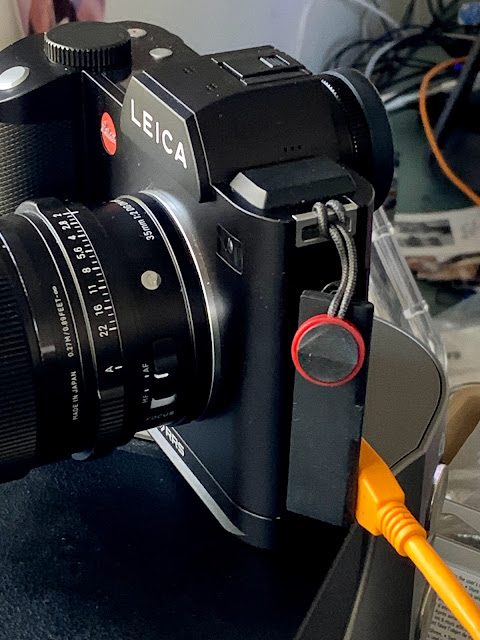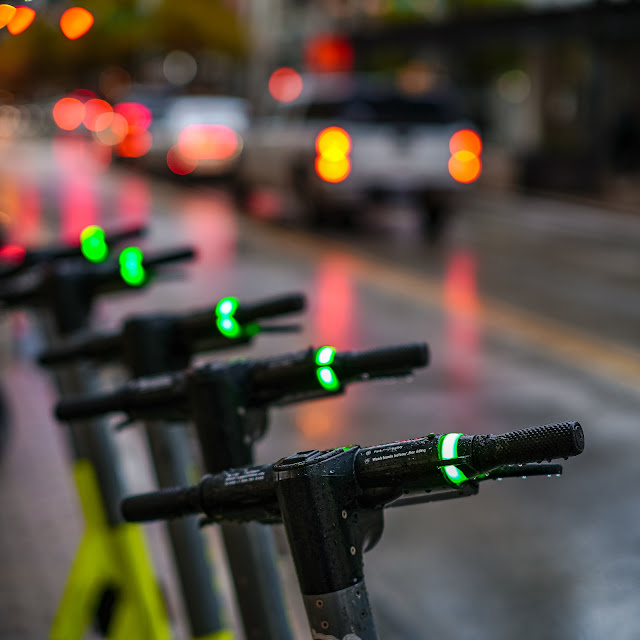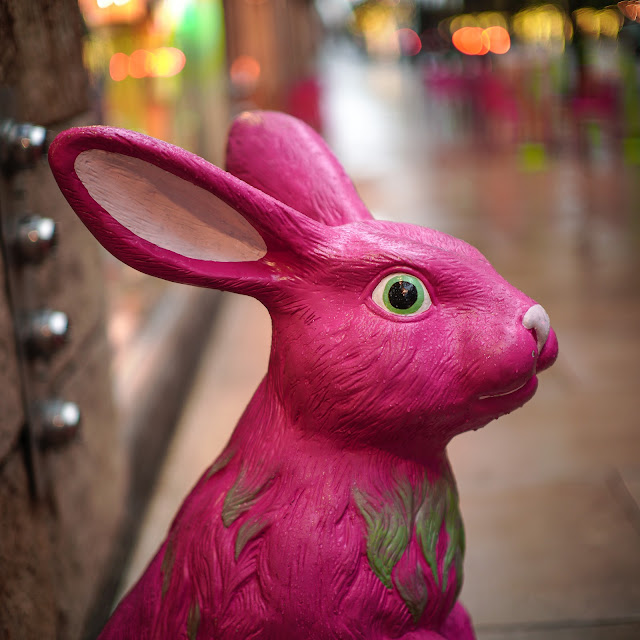This image has nothing to do with the written content of this post. I can't upload images of my clients from yesterday until the client publishes the images on their website but I didn't want you to get here and stare at a non-photographic page.... And everyone likes red/blue contrasts...
About a month ago I wrote of my experiences going on location to the Austin offices of a national accounting firm to make portraits of their employees. The company has been a client now for over a decade and in the past they've always asked for portraits photographed against a gray seamless background. A while back a new internal marketing team took the reins and engineered a completely new branding strategy and a new look for their materials. Gone were the headshots against gray, incoming are environmental portraits taken in the offices, complete with nicely out of focus backgrounds. I couldn't be happier about a style change.
On the first round we spent a day on site, shot in six or seven different locations and ended up making portraits of 19 people. Yesterday I was back for another full day in their Austin facility doing the same thing for 17 more people.
The first time out I photographed everyone with a tripod-mounted Sigma fp camera and the Leica 24-90mm f4.0 lens. I lit almost every portrait that day with a big LED light aimed into a 60 inch, white umbrella. It worked out really well so --- I couldn't do it the same way again. I wanted a little friction of change just to shake up the day a bit.
So, this time I decided to use the Panasonic S5 (one of the most under-appreciated, full frame cameras on the market today!) and I brought along only prime lenses instead of the usual zooms. The lighting was pretty much the same. A 48 inch circular light blocker to put between the portrait subject and the icky fluorescent lights in the ceiling and then a small octa-box with a powerful LED light aimed inside.
In a huge split with past practices I'm lighting and white balancing for the subject and the subject is shielded from the bulk of the ambient light in each location by the light blocker. My in-camera color correction is just for the LED lit subject. I let the background fall wherever it's going to fall. But there is good logic behind this. If I use the ambient light exposure and balance for relative intensity with the subject's light I don't have to do any additional lighting beyond the LED main light. But wait! Won't the background color be icky?
On this particular location the subject was well lit and accurately color balanced but as a result the background was all lit with very yellow/green, icky (VSL technical word), fluorescent lights. It was the kind of color no client really needs to see. So.....why do this?
Well, in the latest rev. of Lightroom Classic you have an extremely powerful set of selection and masking tools. If I include, say, 50 shots of a person in basically the same pose but with a wide range of expressions and tweaks of expressions I can now go in and make an instant selection of the subject and fine tune color, etc. on them. Then I can create a second mask -- automatically -- that includes only the background and quickly color correct and tweak the background any way I want --- including getting a tight match to the foreground/subject color. If that's what I want. Each mask containing its own exposure, color, contrast and sharpness or de-focusing tweaks. Once I have one file looking really nice I can sync that file's settings and masks across all 50 of the similar images in less than a minute. Amazing.
When you think about the sheer control you have over both sections of the image; from subject alone to far background, and you are able to correct for each of the person's files quickly, you can imagine how much improved are the proofs (online galleries) you can share with the client. You no longer have to talk them through how you are going to "fix" files post by "saving" the background. The tools are an amazing addition to LRC and the fact that you can more or less automate giant tranches of the work is game-changing.
Why was this shoot so fun? Well, the client's office has a killer coffee machine, the client trusts me to figure out the locations I want to shoot in and how I'd like to photograph. No one is standing next to me impatiently waiting to "approve" stuff, all the people in the office are half my age but we find each other fun to talk to, and fun to hang out with. The corporate culture is..... mellow. One person stopped in the middle of her session to launch into a long discussion about Birkenstock shoes when she saw my now hard to acquire Birkenstock Bostons. Seems I share a specific shoe appreciation with a 27 year old accountant. She was wearing Arizonas with socks. And she was one of the cool kids. For an accoutant.
The office reminds me very much of the software start-up offices, pre-2001 market crash. There's a fully stocked pantry of snacks that range from vegan and nutritious to crazy delicious but addictive and with borderline dangerous amounts of sugar. They cater-in every lunch. We had delicious ciabatta style pizzas yesterday along with an ample selection of salads. I like working for clients who order, among other things, prosciutto topped pizzas, garnished with arugula and drizzled with a fig sauce. Can't beat it. Not your standard Pizza Hut or Dominos stuff.
I work at a pace I get to set and sometimes I change gears in the middle of a sitting and just try something else. Maybe a different lens or a different light placement. At the end of the day I get really nice feedback from senior staff and they thank me profusely and genuinely for having been there. One partner who was on site came to my last location of the day to chat while I was packing and he said, "It's fun to watch someone work who so obviously loves what they do. Especially when they are so good at it." That's probably going to be the best holiday present I'll get this year. From a client. And I really cherish little moments like that.
Since I wasn't using my typical zooms I guess I should mention what lenses I took along and what I ended up using to do the portraits. I brought along the Sigma 90mm f2.8 lens, the Sigma 85mm f1.4 lens and the Sigma 65mm f2.0 lens. I used the 85mm for the first half of the day and then switched over to the 65mm.
I was composing in landscape format and putting the subjects off center to either the left or the right hand side of the frame. The brief from the new marketing team asked to be able to see both shoulders and to leave some space for the background to read so it was okay to use wider lenses than usual.
My favorite for the day was the 65mm f2.0. It's sharp, neutral, able to be used without fear of failure at f2.8 and I'm pretty sure it's equally sharp at f2.0 (wide open) but I needed some depth of field for the images to work the way they needed to.
I have one more job to complete before I break and start turning everything else down between now and the end of the year. It's on Monday and it's a long day with the agency I did the wine stuff for a year and a half ago. I have a bunch of friends there and I'm going to shoot some portraits in the early part of the afternoon and then stick around and snap some pix at their annual holiday party. Should be fun and mellow and then the remainder of the year is just for me.
If I were to buy another camera right now (which I'm pretty sure I'm not....) it would be another Lumix S5. the camera is close to perfect --- for the money. Loved using it all day yesterday. 100% unfailure rate.














































































